Heróica Veracruz, Veracruz 作者: 来源: 发布时间:2021-07-22
1.Basic data
Pop.: 811,671 (metro)
Area: 241 km2 | Elev.: 10 masl

2. Natural geography
The city of Veracruz belongs to a natural region called Llanuras de Sotavento (Sotavento Plains). This region has the biggest lagoon and reef system of the state, right next to the urban region of Veracruz city. The Sotavento Plains are basically a vast plain área, only partially interrupted by some low-lying hills. This is especially seen in the lower basin of the Papaloapan, a river that at its entrance to Veracruz territory, coming from the state of Oaxaca, is only 11 meters above sea level, so its course is extremely slow and forms numerous meanders, lagoons and swamps.
The coast of the Sotavento Plains is low and sandy, which makes it difficult to install good ports (Veracruz is an artificial port, for which enormous sums of money have been spent).
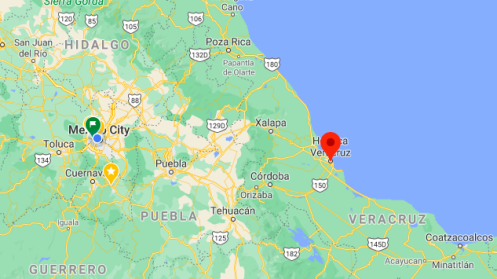
In front of the Veracruz-Boca del Río conurbation area there are several coral reefs and small islands. San Juan de Ulúa, which was previously an island, was connected to the land by a dike, with which it became a peninsula. Another group of coral reefs is located off the tip of Antón Lizardo.
The hydrography of the Sotavento Plains is very rich, with countless streams, rivers, estuaries, swamps, lagoons and lagoons. These rivers are born in the region of the Great Mountains, the mountains of Oaxaca or the region of the Tuxtlas; they flow into the Gulf of Mexico.
The soils of the Leeward Plains are quite varied. There are red and yellow soils of forests, sandy (especially by the sea, where dunes and coastal dunes abound), prairie, limestone (particularly in the semi-arid areas mentioned above), alluvial and marshy. The latter 2 are located mainly in the lagoon areas and on the banks of the Papaloapan River and its tributaries.
Since the Leeward Plains are a long-populated natural region, its forested areas have almost completely disappeared, being replaced by farm fields, pastures, population centers, industrial establishments, etc.
The wild vegetation is made up of palm trees (especially coconut and royal), which in many places form almost continuous masses, and numerous species of trees: almond, amate or fig tree of the ruins, mahogany, red cedar, ceiba, cocuite, chaca or palo mulato, oak, huizache, rubber, white wood, crazy wood, maritime pine, oak, sanguine, etc.
Mangroves abound on the shores of the Gulf of Mexico and the lagoons. In the coastal dunes and dunes, as well as in the less rainy areas, thorny bushes, cactus plants (cardón, nopal, organ) and other xerophytic plants proliferate. On the contrary, in the lagoons and freshwater swamps the popal or aquatic vegetation develops, which abounds in the Socavento Plains more than in any other region of the country.
The wild fauna has regular numbers of squirrels, armadillos, rabbits, coyotes, iguanas, hares, querreques, snakes, opossums, turtles, foxes, skunks and numerous species of birds (cenzontles, hummingbirds, herons, hawks, gulls, parrots, pigeons, pelicans, parakeets, primroses, buzzards). The waters of the Gulf of Mexico, lagoons, lagoons and rivers are rich in crustaceans (clam, shrimp, crab, crab, prawn, oyster), mollusks (snail, octopus) and fish (catfish, bobo, dogfish, cherna, guachinango, lebrancha, lisa, mojarra, snapper, pámpano, snook, sierra, trout), etc.
In the Alvarado lagoon there are still manatees, aquatic mammals in danger of disappearing due to irresponsible hunting and the pollution of rivers and lagoons.
http://bibliotecadigital.conevyt.org.mx/inea%5Cpdf%5C148%5C148008.pdf
Weather
Köppen Classification: Tropical Savanna Climate
Tropical savanna climates have monthly mean temperature above 18°C (64°F) in every month of the year and typically a pronounced dry season, with the driest month having precipitation less than 60mm (2.36 in) of precipitation. In essence, a tropical savanna climate tends to either see less rainfall than a tropical monsoon climate or have more pronounced dry seasons than a tropical monsoon climate. Tropical savanna climates are most commonly found in Africa, Asia and South America. The climate is also prevalent in sections of Central America, northern Australia and North America, specifically in sections of Mexico and the state of Florida in the United States.
The Köppen Climate Classification subtype for this climate is "Aw". (Tropical Savanna Climate).
The average temperature for the year in Veracruz is 75.0°F (23.9°C). The warmest month, on average, is June with an average temperature of 82.0°F (27.8°C). The coolest month on average is January, with an average temperature of 69.0°F (20.6°C).
The average amount of precipitation for the year in Veracruz is 69.1" (1755.1 mm). The month with the most precipitation on average is July with 16.4" (416.6 mm) of precipitation. The month with the least precipitation on average is February with an average of 0.7" (17.8 mm).
https://www.weatherbase.com/weather/weather-summary.php3?s=4667&cityname=Tuxpan%2C+Veracruz%2C+Mexico&units=
Getting there and around
By Air – You can fly to Veracruz from the US and and other points in Mexico including Mexico City and Oaxaca. The international airport is about 5 miles (8 km) south of the city center. Ground transportation is available from the airport into town; buy your tickets from the booth inside the terminal building.
By Bus – You can travel to Veracruz on a luxury bus from Mexico City – the trip takes around 5.5 hours. Veracruz is a major bus hub for the eastern Gulf coast of Mexico and you’ll be able to travel efficiently by bus around Mexico’s entire Gulf region from here if you want to.
By Car – Driving to Veracruz is very fast and efficient using the many high-speed toll roads which connect this region.
Car Rental – To explore Mexico’s provincial towns and cities—including its beach locations and the scenery and attractions near them— consider renting a car for your visit. Having your own car will give you more flexibility than using public transport options and, in some cases, offer you access to places which are otherwise difficult to visit without the use of a car.
Get around
Local Buses – Local buses and mini-buses (combis or micros) are available locally for a fraction of the cost of a taxi around town. You need to speak Spanish to be able to ask for directions or ask the driver to tell you where to get off.
Taxis – Taxis in most of Mexico’s towns and cities are not metered, so agree your price before you get in. Taxi travel is very affordable in Mexico, in comparison to the USA, Canada and Europe, and so provides a viable means of public transportation in Mexico. Your hotel can arrange taxis for you; some post their rates on a board in the lobby; taxi hotel rates are usually higher than cabs you hail off the street. If you speak Spanish, you will have a distinct advantage and be able to negotiate a price with the driver.
Uber is expanding rapidly across Mexico and now offers services in cities across the country, including Mexico City, Toluca, Cuernavaca, Puebla, Querétaro, León, Aguascalientes, San Luis Potosí, Guadalajara, Monterrey, Hermosillo, Tijuana, Mexicali, and Mérida. Uber has been adding Mexican cities to its network every year, check for availability when you arrive at your destination in Mexico.
Cabify is developing also and currently operates in cities including Mexico City, Toluca, Monterrey, Puebla, Querétaro and Tijuana. Check for availability in the city you are visiting.
The services offer people with smartphones a way to book a cab through a mobile app for a pre-agreed price. Fares are comparable with Sitio type cabs (see above), and sometimes trade at a premium to this when local demand increases.
https://www.mexperience.com/transport/taxi-travel-in-mexico/#51
https://www.mexperience.com/travel/colonial/veracruz
3. Economy
GDP: 47 M MXN (2010)
4. Industry
It is known as The Door of Mexico to the World, since the port is and has been the most important in the country from its beginnings in the viceregal era to the present day, for 250 years it was the only port through which goods could enter and leave from Continental America to Europe. The expansion of the Port Area is currently planned with land reclaimed from the sea and others ceded by the federal government, and it is expected that the current capacity of 19.5 million tons will increase to 118 million, and from 19 berth positions to 48 The municipality of Veracruz belongs to the Sotavento economic region.
Its income mainly comes from commerce, since it is a commercial port, followed by tourism, which is also very important since the Veracruz Carnival takes place in this city, which is considered the most important in Mexico. Other common activities are the automotive industry, the steel industry, and fishing. 2.01% of the municipal population is dedicated to the primary sector, 24% to the secondary sector and 67% to the tertiary sector.
Veracruz Port expansion
Much-needed container capacity coming in the spring to the port of Veracruz in the form of a $1.5 billion upgrade underscores the potential behind Mexico’s rapid container trade growth. But it also raises questions on whether country-wide container capacity, highways, and railroads are up to the task.
The first phase of the upgrade, a 1.2 million TEU, $450 million container terminal built and operated by Hutchison Ports, will improve the port’s container handling efficiency and solve a shortage of berth space that sparked sporadic vessel congestion and left vessels waiting for more than a day to get into the existing port.
The Veracruz expansion is the most prominent of 25 port upgrades planned by the Mexican government, at a cost of $5 billion in private and public money, that are designed to provide a maritime system that can cope with the country’s rising cargo volumes and rapidly growing manufacturing sector, especially its auto factories. The Mexican secretary of Communications and Transportation refers to the Veracruz upgrade as the “most import port infrastructure project of the last 100 years.”
The growth of Veracruz, the largest port on Mexico’s Gulf Coast, has been propelled in large part by its proximity to the vast Mexico City population about 400 kilometers (248 miles) away, and the manufacturing sector in central Mexico to the north. Veracruz handles more automobiles than any other Mexican port.
The new terminal will be about the same size as the operator’s existing terminal in the port, but will have a 700-meter (2,296-foot) berth able to handle two mega-ships at once, instead of the one at present, and be 15 meters deep, compared with 13 meters at present. Hutchison said the existing terminal’s berth can take ships of up to 8,500 TEU, and port officials said there is no restriction on vessel size in the new terminal, which can take the largest ships made at present. Hutchison expects to double the terminal’s TEU capacity with further additions within six years.
Later phases of the port expansion include the construction of four other new terminals at the port — the others will handle grain, minerals, liquids, and bulk cargo — that will eventually make Veracruz (Mexico’s second-largest port) larger than the first and third largest ports, Lazaro Cardenas and Manzanillo, combined.
The upgrade involves the construction of an entirely new container terminal, protected by a specially constructed 4.3-kilometer sea wall, to the north of the existing port that will eventually replace Hutchison’s existing terminal.
Hutchison says the new and old terminals will operate simultaneously from the May opening until the existing terminal is closed in November. The operator says that by increasing the number of cranes from five to seven, adding six rubber-tire gantry cranes, and because it has a more efficient terminal footprint. the terminal will boost terminal productivity by 30 percent, from 360 to 468 container movements an hour.
When the second phase of the upgrade is finished, in 2024, the terminal will have a capacity of 2.1 million TEU and a 1,050 meter draft, the operator says.
The existing port’s main problem is the lack of space for vessels to stop in, forcing some to wait up to 36 hours, although the average is 24 hours, said Juan Ignacio Fernandez Carbajal, director general of the administration of the port. Some shippers have reported longer waits, with some ships going to Tuxpan to unload.
https://www.joc.com/port-news/international-ports/veracruz-port-upgrade-dent-mexico%E2%80%99s-capacity-stress_20181220.html
5. Touristic sites
Fort at San Juan de Ulua
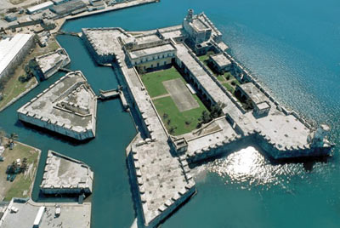
If you’ve ever watched the late 1980’s film “Romancing the Stone” with Michael Douglas and Kathleen Turner, you’ve already seen parts of this fort (towards the end of the film, in the scenes leading up to the alligator swallowing the jewel).
The fort was built by the Spanish (the original construction began in 1565 and was expanded several times) to protect against pirates and, later, was also a defense against foreign invaders. This fort was also the Spaniard’s last foot-hold on Mexico: the last Spanish troops retreated to here before being finally expelled by the Mexicans circa 1825.
After Mexico’s war of independence, the fort later became a notorious prison, especially during the Porfirio Diaz era. Many of the prisoners sent here never lived to be released, because of the harsh conditions, including tuberculosis and yellow fever that were rampant at that time.
Today, the fort complex has been converted in a museum and is a major tourist attraction in Veracruz. It’s easy to get to and is well worth a visit when you are in Veracruz. For a small admission fee you can wander around the fort and old prison and get a feel for the history that unfolded around its walls. English-speaking guides are on hand and, for a small additional fee, will give you a guided tour which may well include a good dose of folklore in addition to historical facts.
Veracruz Aquarium
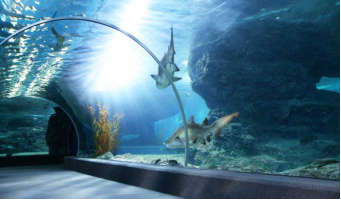
One of Latin America’s largest aquariums is a major attraction in Veracruz. It is host to nearly 25 tanks, some containing saltwater, some containing freshwater. You’ll see species of marine life native to the Gulf of Mexico, including barracudas, sea turtles, manta rays, tiger sharks and manatees. Called simply, El Acuario, you’ll find this on the south-eastern edge of town.
It is considered as one of the most important and most complete in all of Latin America because of its modern technology and functions as a family recreation center. It is a strong pull for tourism in the region because it also promotes education and extends knowledge on aquatic investigation and conservation of marine fauna, particularly from the Gulf of Mexico.
The Veracruz Aquarium Shopping mall, where the Aquarium is housed, has about 200 aquatic organisms arranged in three rooms: the fresh water gallery, the salt water gallery and the ocean tank. It has a shark section, a manatee section and a pool where you can pet the animals.
https://www.bestday.com/Editorial/Veracruz-Aquarium
The Malecón
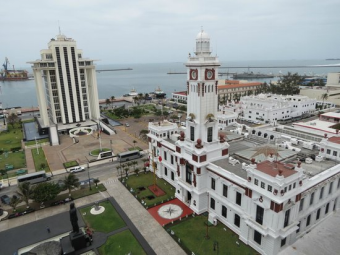
A visit to Veracruz wouldn’t be complete without a leisurely stroll along the boardwalk. This is a great place to watch the locals as they engage with family and friends. Enjoy some ice cream as well, vendors are everywhere.
The malecón (boardwalk) stretches for kilometers along the Gulf of Mexico, leading from the city center into the suburbs. This area is popular at night, when people stroll and exercise, enjoying the ocean breezes. Near the city center, the malecón is crowded with merchants selling knick-knacks, souvenirs, jewelry made with seashells, and T-shirts.
Colonial Center
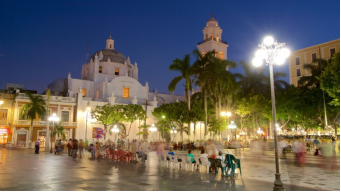
Veracruz’s main plaza, the Plaza de Armas (Plaza of Arms), is situated in the middle of the city; it is a handsome place, featuring palm trees, a colonial fountain and beautiful arches.
The cathedral faces the Plaza de Armas, as does the Palacio Municipal, and various other majestic civil buildings including the Correos y Telegrafos (post office) building and the Aduana Maritima (Maritime Customs) building.
The plaza is also the hub of Veracruz’s social scene, and at night, when the temperature cools, the plaza comes alive with music, dancing and street entertainers.
7. History and Culture
The Spanish captain Juan de Grijalva, along with Bernal Díaz del Castillo, first arrived in 1518 at the island later known as San Juan de Ulúa.[10] The Spanish gave it that name because they landed on the Christian feast of John the Baptist (24 June), and in honor of the captain.[11] De Ulúa is derived from the local name for the Aztecs, coluha or acolhua. According to tradition, when the Spanish arrived, they found two young men who had been sacrificed. When they asked the locals what had happened, they said the Aztecs had ordered the sacrifice. The word for Aztec evolved into Ulúa.
Because the first expedition detected the presence of gold in the region, a second expedition under the command of Hernán Cortés arrived in 1519. Cortés and his men landed at the shore opposite the island where Grijalva had moored, which has the pre-Hispanic name of Chalchihuecan. Cortés, Francisco de Montejo and Alonso Hernández Puertocarrero founded the settlement, naming it Villa Rica de la Vera Cruz. The name Villa Rica (rich village) referred to the gold that was found here and Vera cruz (True Cross) was added because the Cortés expedition landed on Good Friday, a Christian holy day. When Cortés and his soldiers abolished the Aztec despotism and elected a Justicia Mayor and a Capitán General, they created the first city council on the American continent. The city was the first on mainland America to receive a European coat of arms, which was authorized by Carlos V in Valladolid, Spain on 4 July 1523.
The original settlement was moved to what is now known as Antigua, at the mouth of the Huitzilapan (or Antigua River) shortly thereafter. This separated the city from the port, as ships could not enter the shallow river. Ships continued to dock at San Juan de Ulúa, with small boats being used to ferry goods on and off the ships. When large-scale smuggling of goods took place to avoid customs officials, the Spanish Crown ordered the settlement returned to its original site to cut down on that traffic. Docks and an observation tower were constructed on the island to ensure that goods went through customs officials.
As in other parts of Mexico, the indigenous peoples suffered from epidemics of European infectious diseases, which decimated the population after contact. The Spanish began to import African slaves via the port of Veracruz to work on sugarcane plantations. In the 16th century, this state had more slaves than any other in Mexico. Before the slave trade was abolished, Mexico had the second-highest population of African slaves in the Americas, following Brazil.
By the end of the 16th century, the Spanish had constructed roads to link Veracruz with other cities such as Córdoba, Orizaba, Puebla, Xalapa and Perote. Their gold and silver were the principal exports. This caused the city problems with pirates, prompting the construction of Fort San Juan de Ulúa on the island where Grijalva had landed in the mid-16th century. Major public buildings were constructed at the beginning of the 17th century: the municipal palace, the monastery of Nuestra Señora de la Merced, and the Hospital de Nuestra Señora de Loreto. In 1618, a fire nearly reduced much of the city to ashes. In 1640, the Barlovento Armada was stationed here for additional defense against pirates. Through the rest of the colonial period, this was the most important port in New Spain, with a large wealthy merchant class that was more prosperous than that of Mexico City. The pirates Van Hoorn, Laurens de Graaf and Michel de Grammont attacked Vera Cruz in 1683.
The 19th century was marked by armed conflicts. During the Mexican War of Independence, Spain placed troops here to maintain Mexico City's sea link with Spain. In 1816, Antonio López de Santa Anna commanded royalist troops countering the insurgency. In 1820, insurgents took the city, despite Santa Anna's attempts to stop them. The last viceroy of New Spain, Juan O'Donojú, arrived here in 1821, where he signed the Treaty of Córdoba with Agustín de Iturbide at Fort San Juan de Ulúa. In 1823, Spanish troops remaining at Fort San Juan de Ulúa fired on the newly independent Mexican city of Veracruz. The city's defense against the attack earned its first title of "Heroic City". During the Pastry War in 1837, the city mounted a defense against a French attack, and earned its second title of "Heroic City."
In 1847 during the Mexican–American War, United States forces invaded the city. It was defended by generals Juan Morales and José Juan de Landero. The siege continued with brisk firing until 27 March, by which time a considerable breach had been made in the wall surrounding the city. Upon this General Morales, who was Governor of both the city and of San Juan de Ulloa, commenced a correspondence with General Scott looking to the surrender of the town, forts and garrison. On the 29th Vera Cruz and San Juan de Ulloa were occupied by Scott's army. About five thousand prisoners and four hundred pieces of artillery, besides large amounts of small arms and ammunition, fell into the hands of the victorious force. The casualties on the US side during the siege amounted to sixty-four officers and men, killed and wounded.Memoirs of General Grant
Ten years later, civil war between liberals and conservatives forced Benito Juárez's government to flee the capital of Mexico City. Juárez went to Veracruz and governed from there in 1857. In 1861 Spain sent its troops to occupy the port in an effort to secure payment of debts, which Juárez had suspended. French military forces accompanied them to prepare for Maximiliano I and occupied the city when the emperor and his wife Carlota of Belgium arrived in 1864.
The conflicts and damaged trade relations with Europe took its toll on the port of Veracruz. By 1902, the port facilities had deteriorated, and it was considered one of the most dangerous on the American coast. President Porfirio Díaz contracted with foreign enterprises to modernize the port's infrastructure.
Between April - November 1914, during the Mexican Revolution (1910-1920), the US attacked and occupied the port in an effort to try to preserve trade in the dispute with President Huerta. The city gained its fourth title of "Heroic City".
After the Revolution, most port workers became unionized. Through most of the 20th century, federal and state legal and political initiatives intended to better workers' lives had effects on the operations of the port. Eventually, unions came to have great power over the operations and tariffs charged. By the latter part of the 20th century, competing unions made the operations of the port difficult. Some blocked access to the port from federal roads and financial corruption was a problem.
In the 1970s, a federal commission was established to design a new administrative system for the ports of Mexico. The legislature passed laws authorizing the federal government to take control over important ports such as Veracruz. The federal government modernized the port, adopting automation of loading and unloading. This resulted in a reduction of 80% of the port's jobs and labor resistance through strikes. The dockworkers' unions unified, negotiating for members to have a stake in a new company to manage the port's functions, named the Empresa de Servicios Portuarios de Veracruz, S.A. de C.V. The old Compañia Terminal de Veracruz was dissolved in 1988 and the new organization was fully in place by 1991.
In September 2010, Hurricane Karl, a small, strong Category 3 hurricane, caused widespread flooding and damage affecting approximately half a million people. Sixteen were confirmed dead with another eleven missing. Sixty-five municipalities in the state were declared disaster areas. Preliminary damage estimates total up to US$3.9 billion and $50 billion MXN.
Much of the most recent commercial development has been in newer areas in the south of the city and in the neighboring municipality of Boca del Río, linked by a ten-kilometer road along the shore that caters to tourists and business travelers. The hotels in Veracruz are more rustic and traditional; the modern ones are in Boca del Río, especially near Playa Mocambo.
8.Contact Information
City Mayor: Fernando Yunes Márquez
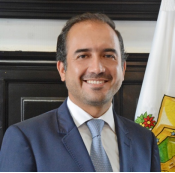
Contact number: +52 (783)
Govt. Office Address: Zaragoza esq. M. Molina s/n, Col. Centro, Veracruz, Ver.
Twitter: https://twitter.com/FYunesMarquez
Facebook: https://www.facebook.com/FYunesMarquez
Website: https://www.veracruzmunicipio.gob.mx
E-mail: hola@veracruzmunicipio.gob.mx
